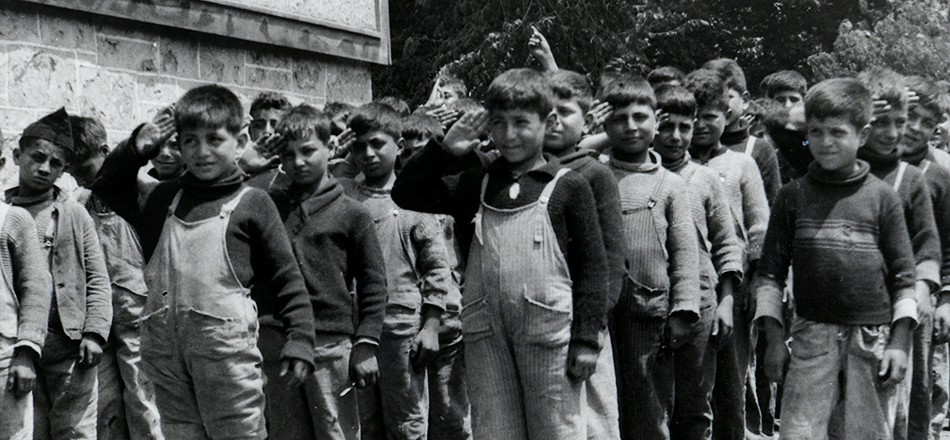A group of Georgetown Boys. Photo by Aris Alexanian (1923-1927)
By: Isabel Kaprielian-Churchill
In this brief essay, I would like to juxtapose two important historical events: World War I and the creation of the Armenian Republic, while highlighting the relationship between Canadians and Armenians.
World War I was a muddy hell of trenches, poison gas, U-boat attacks, of the sacrifice of hundreds of thousands of young lives, and the deportation and massacre of civilian populations.
Canadians fought gallantly in that bloody conflict, notably at Vimy Ridge in 1917. Starting in August of the following year, the Canadian Expeditionary Force spearheaded the Allied offensive that ultimately ended on Nov. 11, 1918. This period is known as Canada’s One Hundred Days.
Approximately 620,000 Canadian men and women enlisted in the war. About 420,000 went overseas and almost 60,000 perished. This is a significant percentage of a population that numbered only 8,000,000 in 1916.
For Canadians, the war ushered in a period of maturity in military, political, and diplomatic arenas both during and after hostilities. In 2018, we commemorated the 100th anniversary of the end of WWI, of Canada’s vital role in that conflict, and of Canada’s stand on the international scene.
The Great War profoundly transformed the world. In the wake of the war, dynasties crumbled, like the Romanovs in Russia and the Hapsburgs in Austria. Empires, too, collapsed, like the German and Ottoman empires. In their place, new countries or mandated territories emerged: Iraq, Saudi Arabia, Syria, and the Republic of Armenia.
A few years ago, we commemorated the 100th anniversary of the creation of the Armenian republic, which was, as former Ambassador Marderosian has stated, really the rebirth of Armenian sovereignty.
In 2018, then, we remembered two critically significant historical events: the end of the war and Canada’s participation in it, and the birth or rebirth of a new Armenia.
Although Canadians and Armenians were worlds away, a bond existed between these two peoples. Let me briefly mention three areas of this surprisingly strong relationship.
1. RELIGION:
The Anglican and Armenian churches have a close theological connection. When Armenian immigrants settled in Canada, they attended Anglican churches for their spiritual life and their rites of passage. For example, Holy Trinity Church in Toronto, Grace Anglican in Brantford, and St. Philip’s in Hamilton.
Equally impressive, Canadian Protestant missionaries – largely Presbyterian, Congregationalist, and Methodist -worked among the Armenians in the Ottoman empire. Historian Daniel Ohanian has listed just under 70 Canadians stationed in the Ottoman empire before 1914, most of them associated with the American Board of Commissioners for Foreign Missions (ABCFM). One of the most distinguished missionary families from Canada and the United State was the Chambers family from the Woodstock area in Ontario.
One sometimes wonders why Protestant missionaries were evangelizing among Armenians, who were the first people to adopt Christianity as a state religion and who stood as one of the bastions of Eastern Christendom. Protestant missionaries did, indeed, proselytize among Armenian Apostolic Christians. They were also inspired by the Social Gospel to build schools and colleges, clinics and hospitals.
2. PHILANTHROPY.
Following the Armistice in 1918, western countries, especially the United States, launched rescue and rehabilitation measures to aid the Armenian survivors of the Genocide. Canadians participated whole-heartedly in this international movement. In 1920, for example, Canadians raised a vast sum, almost $300,000 for Armenian refugees abroad. Some of these funds were used to refurbish a Greek hospital in Constantinople as a children’s tuberculosis hospital.
Canadian relief volunteers joined missionary personnel and Near East Relief workers in the Middle East, the Caucasus, and Greece to aid the refugees. Women like registered nurses, Emma Wood of Sarnia, Ontario, and Sara Corning of Nova Scotia served in orphanages, hospitals, and refugee camps.
Probably the most innovative rescue operation was the initiative of the Armenian Relief Association of Canada. Linked to the London Lord Mayor’s Fund, the Association brought in 109 orphan boys to settle on a farm/home near Georgetown, Ontario, paid mainly through public subscription by Canadians. The Association and its successor, the United Church, also sponsored the entry of 38 girls and young women to work as domestics in southern Ontario, mostly in Toronto.
In addition to the religious and the philanthropic connections, let us now move on to the military relationship.
3.MILITARY
When Britain declared war on Germany on August 4, 1914, Canada immediately offered to raise an army of 20,000 men. Mobilization started on August 8 and by September 4, approximately 32,000 Canadian men had assembled at the military camp at Valcartier, Quebec.
Among these early recruits were at least two Armenian immigrants, Bagharsak [Vagharshag] Baronian, 31 and Ohanas [Ohannes} Vartanian, 21. A few weeks later, this vanguard of Canadian forces sailed for England for further training. Baronian and Vartanian were part of the First Canadian Division, the 48th Highlanders, which joined the British First Army under the command of the British General, Sir Douglas Haig. Four Canadian Divisions eventually made up the Canadian Expeditionary Force (CEF), also known as the Canadian Corps. It would take another three years before Canadian troops fell under the command of a Canadian – General Sir Arthur Currie.
Vartanian, the 21 year-old, was severely wounded on March 8, 1915 and died a month later, one of the first casualties of the CEF. Baronian was killed in action on June 17, 1915.
The following year, a 17 year-old Armenian, an immigrant from the region of Keghi, enlisted in the CEF. Being underage, he was withdrawn by his parents. As soon as he turned 18, Samuel Chichegian of Brantford, Ontario re-enlisted. After training in Hamilton as a machine gunner, he sailed for England in December, 1917.
In his letters to his mother – all in 1918 – Sammy writes: “England is a great country but everything is twice as high as it is in Canada. England is feeling the war all right, while Canada is just realizing there is a war on …They have air-raids here quite often. We had two this week but the planes were brought down … The war may be over by June.”
Sammy wanted to ensure that his mother was receiving his pay and that her parcels to him arrived intact: “Have you received the money for January and February yet? I haven’t received the box yet, most of them get stolen or half emptied before they reach us, what was in it?” (Kent, Feb. 6, 1918).
Still in England, Sammy wrote: “I suppose they’re starting to give out food cards [in Canada] too, but don’t kick [complain], because the only people who get enough to eat are the soldiers, you can thank your lucky stars the family is not in England. I hope everybody is all right at home and working.” (Kent, Feb. 10, 1918)
Sometime in 1918, he was transferred to France where he wrote that “The weather is jake [fine] at present, only too warm … The French people are very kind as we often are invited in some farms for a feed and leave with a couple of chickens so you see we have nothing to kick about …” (France, 1918).
Sammy tried to reassure his mother, for she was desperate to have him returned to Canada. “I know you must feel worried mother, but there is no use trying to get me to quit when I’ve come so far. I’m trying to do my share.” (Somewhere in France, sometime in 1918)
Young Sammy gave more than his share. He was killed in action in France on September 2, 1918, two months before the Armistice and during the crucial period of Canada’s 100 Days when Canadian troops led the Allied offensive that brought an end to the war.
Samuel Chichegian was the youngest person from Brantford to volunteer and die in the Great War and, like many other Armenian immigrants, he gave his life for his new homeland.

Medals awarded to Private Siragan Siroonian in World War I who volunteered for the Canadian Expeditionary Force (CEF). From left to right: “The Great War for Civilization, 1914-1918”, “For Bravery in the Field”, “George V Medal”. Photo submitted by Ara Siroonian.
In 1916,- the same year that Sammy enlisted – twenty-seven-year old Siragan Siroonian, also from Keghi, volunteered for the Canadian Expeditionary Force (CEF). For his bravery during the capture of Parvillers on August 14, 1918, Siroonian was awarded the Military Medal and was praised as “an inspiration to all ranks.” This young Armenian did not escape unscathed. He was the victim of a gas attack. Like many casualties of this dreaded poison, he died young, after years of suffering.
It is tragically ironic that at the same time that men like Baronian, Vartanian, Chichegian, and Siroonian were fighting and dying in France and Belgium, their relatives in Turkey were being deported, robbed, and massacred.
The German gas attack at Ypres, in Belgium, where 6,000 Canadians were killed, wounded, or missing, started on April 22, 1915. Two days later, on April 24, 1915, under cover of war, Turkish authorities began the wholesale arrest and murder of Armenian leaders and intellectuals. War and Genocide.
The Armenian Genocide (1915-1923) and the tragedy of the Armenian people were well-known throughout Canada. Less publicized was the contribution of Armenians to the Canadian forces. The fledgling Armenian community in Canada provided the war effort with an astonishingly high percentage of recruits.
In 1914, at the outbreak of war, approximately 1,500 Armenians had immigrated to Canada. Some had returned to the old country and some had moved to the United States. Of those who remained in Canada I guestimate that about 1,000 were men eligible for military duty.
The records of the CEF yield approximately 150 names of Armenian soldiers, revealing about a 15% enlistment rate – a very high proportion for any ethnic group in Canada, taken on a per capita basis. Of these 150 men, a sample of 37 files, was selected randomly. My son, author and musician, Albert Kaprielian and I examined these detailed and illuminating records.
I would like to mention just three of our findings:
1.All Armenian soldiers were immigrants and I doubt if any were Canadian citizens at the time of enlistment.
2.Most of the recruits came from the region of Keghi in the province of Erzeroum, reflecting the origin of the majority of Armenian immigrants in Canada at the time.
3.Another noteworthy characteristic was the high proportion of volunteers. Of the thirty-seven we examined, thirty-one had volunteered and all were sent overseas. Only six were drafted, after Canada started conscription in 1917.
While most Armenian Canadians engaged in the war, enlisted in the CEF, a much smaller contingent volunteered for the Eastern front. After initial training in the United States, they were shipped to Murmansk in Russia and from there, transported to the Caucasus, to join Armenian regiments fighting to liberate their ancient homeland.
On May 28, 1918, Armenians everywhere celebrated the resurrection of a long hoped-for independent and free state. Five months later they hailed the Armistice and the hope of world peace.
That republic collapsed in the face of overwhelming odds. But today, as we approach May 28, we remember the heroism and commitment of our ancestors who fought for freedom in Flanders Fields and on the plains of Sardarabad.
A new Armenian Republic and a sister Artsakh have been created from the ashes of the Soviet Union. We salute this new Armenia, revitalized and supported by Armenian Canadians and a vast diaspora around the world.

